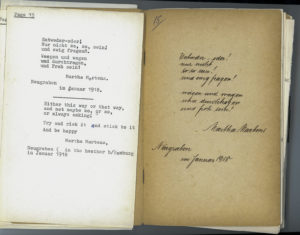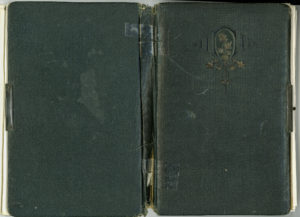 This week I found an autograph book I forgot about, completely. In this limbo period of lock-down, I’m doing what I suggested to many of my clients. Go to the storage locker and take photos. If your sons and daughters don’t want the contents, they have photos in the Cloud. So when I have two free hours, I go to Goleta and rummage through my expensive second garage.
This week I found an autograph book I forgot about, completely. In this limbo period of lock-down, I’m doing what I suggested to many of my clients. Go to the storage locker and take photos. If your sons and daughters don’t want the contents, they have photos in the Cloud. So when I have two free hours, I go to Goleta and rummage through my expensive second garage.
My dear grandmother, born in Hamburg, immigrated in her early twenties. She brought with her an autograph book to the new world. She wrapped the book in an old newspaper from 1974 and addressed it to me. I stuck it in the storage unit during one move and forgot about it. And it’s a treasure.
Most of the signatures date from 1918, when she must have been 16-17 years old, perhaps graduating from school. I found poems, guidance from her schoolteachers, classmates, relatives, all beautifully written in pen and ink.
The older German handwriting is so delicate I barely make it out. My grandmother cut paper of the right size as a cover for each of the pages, and she typed the English translations of all the sentiments. She must have worked for hours, because the translations are often difficult (try to translate a poem) or personally directed. In her typed notes she gave me indications of WHY. One entry says, “written to me in the heather.” She must have relaxed with a girlfriend in a Hamburg park because the friend wrote a suggestion for living well. What a blessing in these dark times to discover the love between friends in 1918. That friend became my dear Oma, as we called her later.
We find autograph books in the US
But they began in Germany. Calvin’s friend had one signed by Calvin in 1545. Other religious folks collected their mentor’s thoughts in their family Bibles. Bibles in the 17th and 18th centuries contained blank pages where we find signatures and annotated sayings. Common folk owned common Bibles with common annotations, all dear. Aristocratic families had pages emblazoned with their family crest and family mottos. So the family Bibles in the 17th and 18th centuries were the first yearbooks.
The autographed Bible gave way to the autograph book
Scholars carried the Stammbuch from university to university, recording colleague’s signatures. This became the predecessor to the reference bibliography.
In the 19th century German fraternities discovered them, and they became records of teachers and classmates. By the 19th century young women collected sayings and held them dear. German immigrants brought them to the US during the Civil War period and used them as a method for retaining sentiments in America.
These books are formatted vertically or horizontally and can be beautifully covered in embossed leather. In my grandmother’s case her book was bound in deep green impressed paper with a Nouveau flower on the cover.
The first signatory was Oma’s stepdad, who told my young grandmother that riches are not worth the shine. Look to other riches, he suggested. My grandmother married a man in the US who invented something wonderful, and in later life they became wealthy. She never let that wealth change her. Perhaps she remembered her stepdad’s admonition?
Value of an Autograph Book?
 Two factors make these books valuable, the celebrities who signed them, the cultural time at the time of signing, and how the times speak through the simple sentiments inside. In the case of my grandmother’s book I see the tenor of the time as the German Revolution of 1918-19 at the tail end of WWI. When friends wrote in my grandmother’s book Emperor Wilhelm II abdicated his throne in favor of a German Federal Constitutional Monarchy which became known as the Weimar Republic. The abject defeat of Germany, the poverty that ensued, and the conflict between the haves and have nots created discord. The Social Democrats came into power, and my grandmother received her education in such a school.
Two factors make these books valuable, the celebrities who signed them, the cultural time at the time of signing, and how the times speak through the simple sentiments inside. In the case of my grandmother’s book I see the tenor of the time as the German Revolution of 1918-19 at the tail end of WWI. When friends wrote in my grandmother’s book Emperor Wilhelm II abdicated his throne in favor of a German Federal Constitutional Monarchy which became known as the Weimar Republic. The abject defeat of Germany, the poverty that ensued, and the conflict between the haves and have nots created discord. The Social Democrats came into power, and my grandmother received her education in such a school.
The first Weimar National assembly took place in the new year of 1919 and Germany had a parliamentary system. The cultural climate matters to her little book, written 1918-1920, and I noticed the sayings deal with the fleeting nature of money and riches. Because these books were popular for the common sentiments, the German name for them is poesiealben.
If you have an autograph book, look for famous names. The two most valuable existing are Beethoven’s and Babette Koch’s books.
My Oma’s book is not valuable to anyone but me, but it must have been grand for the young woman who became my Oma to watch her stepfather sign the first page. She brought it in her small suitcase to the new country in the beginning of the 1920’s.
My grandmother’s bible held the names of her and my grandfathers siblings and parents – a treasure for our family.
Finding your Oma’s Book is so special and more than 100
Years have passed but we seem to find a lot of similarities in both times of health emergencies and wars.
When will we learn?